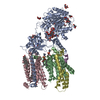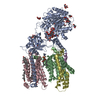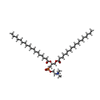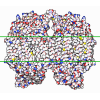[English] 日本語
 Yorodumi
Yorodumi- PDB-8x52: Cryo-EM structure of human gamma-secretase in complex with Abeta49 -
+ Open data
Open data
- Basic information
Basic information
| Entry | Database: PDB / ID: 8x52 | |||||||||||||||||||||||||||||||||||||||||||||
|---|---|---|---|---|---|---|---|---|---|---|---|---|---|---|---|---|---|---|---|---|---|---|---|---|---|---|---|---|---|---|---|---|---|---|---|---|---|---|---|---|---|---|---|---|---|---|
| Title | Cryo-EM structure of human gamma-secretase in complex with Abeta49 | |||||||||||||||||||||||||||||||||||||||||||||
 Components Components |
| |||||||||||||||||||||||||||||||||||||||||||||
 Keywords Keywords | MEMBRANE PROTEIN / Intramembrane protease / gamma-secretase / presenilin-1 / MEMBRANE PROTEIN-HYDROLASE complex | |||||||||||||||||||||||||||||||||||||||||||||
| Function / homology |  Function and homology information Function and homology informationCajal-Retzius cell differentiation / positive regulation of L-glutamate import across plasma membrane / amyloid precursor protein biosynthetic process / negative regulation of core promoter binding / positive regulation of endopeptidase activity / gamma-secretase complex / short-term synaptic potentiation / aspartic endopeptidase activity, intramembrane cleaving / positive regulation of amyloid precursor protein biosynthetic process / smooth endoplasmic reticulum calcium ion homeostasis ...Cajal-Retzius cell differentiation / positive regulation of L-glutamate import across plasma membrane / amyloid precursor protein biosynthetic process / negative regulation of core promoter binding / positive regulation of endopeptidase activity / gamma-secretase complex / short-term synaptic potentiation / aspartic endopeptidase activity, intramembrane cleaving / positive regulation of amyloid precursor protein biosynthetic process / smooth endoplasmic reticulum calcium ion homeostasis / Noncanonical activation of NOTCH3 / protein catabolic process at postsynapse / TGFBR3 PTM regulation / sequestering of calcium ion / Notch receptor processing / synaptic vesicle targeting / positive regulation of coagulation / central nervous system myelination / negative regulation of axonogenesis / membrane protein intracellular domain proteolysis / skin morphogenesis / choline transport / T cell activation involved in immune response / NOTCH4 Activation and Transmission of Signal to the Nucleus / dorsal/ventral neural tube patterning / ciliary rootlet / neural retina development / regulation of resting membrane potential / L-glutamate import across plasma membrane / Regulated proteolysis of p75NTR / myeloid dendritic cell differentiation / regulation of phosphorylation / metanephros development / amyloid-beta complex / growth cone lamellipodium / cellular response to norepinephrine stimulus / endoplasmic reticulum calcium ion homeostasis / brain morphogenesis / growth cone filopodium / microglia development / locomotion / collateral sprouting in absence of injury / amyloid precursor protein metabolic process / regulation of synaptic vesicle cycle / Formyl peptide receptors bind formyl peptides and many other ligands / axo-dendritic transport / regulation of long-term synaptic potentiation / regulation of Wnt signaling pathway / regulation of synapse structure or activity / regulation of postsynapse organization / axon midline choice point recognition / astrocyte activation involved in immune response / embryonic limb morphogenesis / cell fate specification / regulation of canonical Wnt signaling pathway / NMDA selective glutamate receptor signaling pathway / regulation of spontaneous synaptic transmission / mating behavior / aggresome / myeloid cell homeostasis / growth factor receptor binding / skeletal system morphogenesis / peptidase activator activity / Hydrolases; Acting on peptide bonds (peptidases); Aspartic endopeptidases / azurophil granule membrane / Golgi cisterna membrane / G protein-coupled dopamine receptor signaling pathway / Golgi-associated vesicle / glutamate receptor signaling pathway / PTB domain binding / positive regulation of amyloid fibril formation / Insertion of tail-anchored proteins into the endoplasmic reticulum membrane / Lysosome Vesicle Biogenesis / astrocyte projection / neuron remodeling / Deregulated CDK5 triggers multiple neurodegenerative pathways in Alzheimer's disease models / : / blood vessel development / amyloid-beta formation / mitochondrial transport / amyloid precursor protein catabolic process / heart looping / nuclear envelope lumen / regulation of neuron projection development / positive regulation of dendritic spine development / adult behavior / dendrite development / positive regulation of protein metabolic process / cerebral cortex cell migration / smooth endoplasmic reticulum / positive regulation of receptor recycling / TRAF6 mediated NF-kB activation / nuclear outer membrane / membrane protein ectodomain proteolysis / Advanced glycosylation endproduct receptor signaling / signaling receptor activator activity / negative regulation of long-term synaptic potentiation / modulation of excitatory postsynaptic potential / The NLRP3 inflammasome / negative regulation of apoptotic signaling pathway Similarity search - Function | |||||||||||||||||||||||||||||||||||||||||||||
| Biological species |  Homo sapiens (human) Homo sapiens (human) | |||||||||||||||||||||||||||||||||||||||||||||
| Method | ELECTRON MICROSCOPY / single particle reconstruction / cryo EM / Resolution: 2.9 Å | |||||||||||||||||||||||||||||||||||||||||||||
 Authors Authors | Guo, X. / Yan, C. / Lei, J. / Zhou, R. / Shi, Y. | |||||||||||||||||||||||||||||||||||||||||||||
| Funding support |  China, 1items China, 1items
| |||||||||||||||||||||||||||||||||||||||||||||
 Citation Citation |  Journal: Science / Year: 2024 Journal: Science / Year: 2024Title: Molecular mechanism of substrate recognition and cleavage by human γ-secretase. Authors: Xuefei Guo / Haotian Li / Chuangye Yan / Jianlin Lei / Rui Zhou / Yigong Shi /  Abstract: Successive cleavages of amyloid precursor protein C-terminal fragment with 99 residues (APP-C99) by γ-secretase result in amyloid-β (Aβ) peptides of varying lengths. Most cleavages have a step ...Successive cleavages of amyloid precursor protein C-terminal fragment with 99 residues (APP-C99) by γ-secretase result in amyloid-β (Aβ) peptides of varying lengths. Most cleavages have a step size of three residues. To elucidate the underlying mechanism, we determined the atomic structures of human γ-secretase bound individually to APP-C99, Aβ49, Aβ46, and Aβ43. In all cases, the substrate displays the same structural features: a transmembrane α-helix, a three-residue linker, and a β-strand that forms a hybrid β-sheet with presenilin 1 (PS1). Proteolytic cleavage occurs just ahead of the substrate β-strand. Each cleavage is followed by unwinding and translocation of the substrate α-helix by one turn and the formation of a new β-strand. This mechanism is consistent with existing biochemical data and may explain the cleavages of other substrates by γ-secretase. | |||||||||||||||||||||||||||||||||||||||||||||
| History |
|
- Structure visualization
Structure visualization
| Structure viewer | Molecule:  Molmil Molmil Jmol/JSmol Jmol/JSmol |
|---|
- Downloads & links
Downloads & links
- Download
Download
| PDBx/mmCIF format |  8x52.cif.gz 8x52.cif.gz | 262.5 KB | Display |  PDBx/mmCIF format PDBx/mmCIF format |
|---|---|---|---|---|
| PDB format |  pdb8x52.ent.gz pdb8x52.ent.gz | 203.9 KB | Display |  PDB format PDB format |
| PDBx/mmJSON format |  8x52.json.gz 8x52.json.gz | Tree view |  PDBx/mmJSON format PDBx/mmJSON format | |
| Others |  Other downloads Other downloads |
-Validation report
| Summary document |  8x52_validation.pdf.gz 8x52_validation.pdf.gz | 918.9 KB | Display |  wwPDB validaton report wwPDB validaton report |
|---|---|---|---|---|
| Full document |  8x52_full_validation.pdf.gz 8x52_full_validation.pdf.gz | 943.8 KB | Display | |
| Data in XML |  8x52_validation.xml.gz 8x52_validation.xml.gz | 30.8 KB | Display | |
| Data in CIF |  8x52_validation.cif.gz 8x52_validation.cif.gz | 45.9 KB | Display | |
| Arichive directory |  https://data.pdbj.org/pub/pdb/validation_reports/x5/8x52 https://data.pdbj.org/pub/pdb/validation_reports/x5/8x52 ftp://data.pdbj.org/pub/pdb/validation_reports/x5/8x52 ftp://data.pdbj.org/pub/pdb/validation_reports/x5/8x52 | HTTPS FTP |
-Related structure data
| Related structure data |  38059MC  8x53C  8x54C M: map data used to model this data C: citing same article ( |
|---|---|
| Similar structure data | Similarity search - Function & homology  F&H Search F&H Search |
- Links
Links
- Assembly
Assembly
| Deposited unit | 
|
|---|---|
| 1 |
|
- Components
Components
-Protein , 3 types, 3 molecules EAB
| #1: Protein | Mass: 13800.604 Da / Num. of mol.: 1 Source method: isolated from a genetically manipulated source Source: (gene. exp.)  Homo sapiens (human) / Gene: APP, A4, AD1 / Production host: Homo sapiens (human) / Gene: APP, A4, AD1 / Production host:  Homo sapiens (human) / References: UniProt: P05067 Homo sapiens (human) / References: UniProt: P05067 |
|---|---|
| #2: Protein | Mass: 78473.555 Da / Num. of mol.: 1 Source method: isolated from a genetically manipulated source Source: (gene. exp.)  Homo sapiens (human) / Gene: NCSTN, KIAA0253, UNQ1874/PRO4317 / Production host: Homo sapiens (human) / Gene: NCSTN, KIAA0253, UNQ1874/PRO4317 / Production host:  Homo sapiens (human) / References: UniProt: Q92542 Homo sapiens (human) / References: UniProt: Q92542 |
| #3: Protein | Mass: 52712.551 Da / Num. of mol.: 1 Source method: isolated from a genetically manipulated source Source: (gene. exp.)  Homo sapiens (human) / Gene: PSEN1, AD3, PS1, PSNL1 / Production host: Homo sapiens (human) / Gene: PSEN1, AD3, PS1, PSNL1 / Production host:  Homo sapiens (human) Homo sapiens (human)References: UniProt: P49768, Hydrolases; Acting on peptide bonds (peptidases); Aspartic endopeptidases |
-Gamma-secretase subunit ... , 2 types, 2 molecules CD
| #4: Protein | Mass: 29017.943 Da / Num. of mol.: 1 Source method: isolated from a genetically manipulated source Source: (gene. exp.)  Homo sapiens (human) / Gene: APH1A, PSF, CGI-78, UNQ579/PRO1141 / Production host: Homo sapiens (human) / Gene: APH1A, PSF, CGI-78, UNQ579/PRO1141 / Production host:  Homo sapiens (human) / References: UniProt: Q96BI3 Homo sapiens (human) / References: UniProt: Q96BI3 |
|---|---|
| #5: Protein | Mass: 12038.029 Da / Num. of mol.: 1 Source method: isolated from a genetically manipulated source Source: (gene. exp.)  Homo sapiens (human) / Gene: PSENEN, PEN2, MDS033 / Production host: Homo sapiens (human) / Gene: PSENEN, PEN2, MDS033 / Production host:  Homo sapiens (human) / References: UniProt: Q9NZ42 Homo sapiens (human) / References: UniProt: Q9NZ42 |
-Sugars , 3 types, 12 molecules 
| #6: Polysaccharide | 2-acetamido-2-deoxy-beta-D-glucopyranose-(1-4)-2-acetamido-2-deoxy-beta-D-glucopyranose Source method: isolated from a genetically manipulated source #7: Polysaccharide | beta-D-mannopyranose-(1-3)-[beta-D-mannopyranose-(1-6)]beta-D-mannopyranose-(1-4)-2-acetamido-2- ...beta-D-mannopyranose-(1-3)-[beta-D-mannopyranose-(1-6)]beta-D-mannopyranose-(1-4)-2-acetamido-2-deoxy-beta-D-glucopyranose-(1-4)-2-acetamido-2-deoxy-beta-D-glucopyranose | Source method: isolated from a genetically manipulated source #8: Sugar | ChemComp-NAG / |
|---|
-Non-polymers , 2 types, 4 molecules 


| #9: Chemical | | #10: Chemical | |
|---|
-Details
| Has ligand of interest | Y |
|---|---|
| Has protein modification | Y |
-Experimental details
-Experiment
| Experiment | Method: ELECTRON MICROSCOPY |
|---|---|
| EM experiment | Aggregation state: PARTICLE / 3D reconstruction method: single particle reconstruction |
- Sample preparation
Sample preparation
| Component | Name: Human gamma-secretase in complex with Abeta49 / Type: COMPLEX / Entity ID: #1-#5 / Source: RECOMBINANT |
|---|---|
| Molecular weight | Experimental value: NO |
| Source (natural) | Organism:  Homo sapiens (human) Homo sapiens (human) |
| Source (recombinant) | Organism:  Homo sapiens (human) Homo sapiens (human) |
| Buffer solution | pH: 7.4 |
| Specimen | Embedding applied: NO / Shadowing applied: NO / Staining applied: NO / Vitrification applied: YES |
| Vitrification | Cryogen name: ETHANE |
- Electron microscopy imaging
Electron microscopy imaging
| Experimental equipment |  Model: Titan Krios / Image courtesy: FEI Company |
|---|---|
| Microscopy | Model: FEI TITAN KRIOS |
| Electron gun | Electron source:  FIELD EMISSION GUN / Accelerating voltage: 300 kV / Illumination mode: FLOOD BEAM FIELD EMISSION GUN / Accelerating voltage: 300 kV / Illumination mode: FLOOD BEAM |
| Electron lens | Mode: BRIGHT FIELD / Nominal defocus max: 1800 nm / Nominal defocus min: 1500 nm |
| Image recording | Electron dose: 50 e/Å2 / Film or detector model: GATAN K3 (6k x 4k) |
- Processing
Processing
| EM software | Name: PHENIX / Category: model refinement | ||||||||||||||||||||||||
|---|---|---|---|---|---|---|---|---|---|---|---|---|---|---|---|---|---|---|---|---|---|---|---|---|---|
| CTF correction | Type: PHASE FLIPPING AND AMPLITUDE CORRECTION | ||||||||||||||||||||||||
| 3D reconstruction | Resolution: 2.9 Å / Resolution method: FSC 0.143 CUT-OFF / Num. of particles: 463727 / Symmetry type: POINT | ||||||||||||||||||||||||
| Refine LS restraints |
|
 Movie
Movie Controller
Controller





 PDBj
PDBj

































